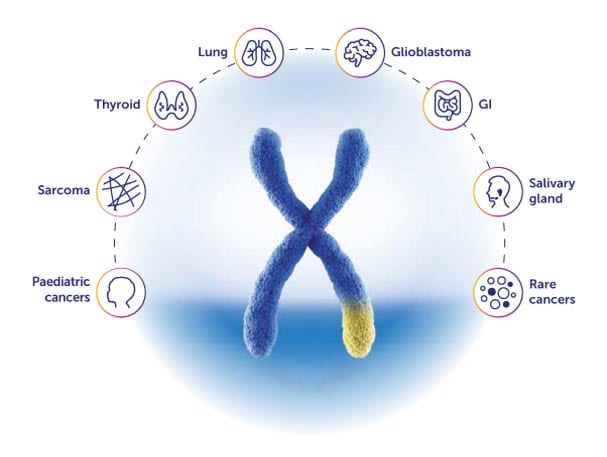NTRK gene fusions are often a primary oncogenic driver across multiple tumours in adults and children1,2
In TRK fusion-driven cancer, the neurotrophic tyrosine receptor kinase (NTRK) gene fuses with an unrelated gene, causing overexpression of the TRK protein.2
NTRK fusions may be mutually exclusive of other known oncogenic drivers,3,4 and are seen not only in rare cancer types but are found at low frequency in many common tumours too.5,6
The presence of TRK proteins has been associated with more aggressive cancer in some tumour types, highlighting an unmet medical need among NTRK fusion cancer patients.7-9
HOVER EACH CANCER TYPE
TO DISPLAY THE PREVALENCE
Estimated frequency of NTRK gene fusion in paediatric solid tumours:
infantile fibrosarcoma (IFS)1,2
congenital mesoblastic nephroma2, 4
high-grade glioma3
papillary thyroid carcinoma5
Estimated NTRK gene fusion frequencies in various cancers are based on reports from isolated studies that used variable testing methodologies. Not all of these tumour types were treated in the clinical trials with VITRAKVI.
References:
- Bourgeois JM, Knet al. Am J Surg Pathol. 2000;24(7):937-946.
- Rubin BP, et al. Am J Pathol. 1998;153(5):1451-1458.
- Wu G, et al. Nat Genet. 2014;46(5):444-450.
- Argani P, et al. Mod Pathol. 2000;13(1):29-36.
- Prasad ML, et al. Cancer. 2016;122(7):1097-1107.
Estimated frequency of NTRK gene fusion in sarcoma: 1%1
Estimated NTRK gene fusion frequencies in various cancers are based on reports from isolated studies that used variable testing methodologies. Not all of these tumour types were treated in the clinical trials with VITRAKVI.
References:
- Stransky N, et al. Nat Commun. 2014;5:4846.
Estimated frequency of NTRK gene fusion in thyroid cancer: 2.4%-12%1,2*
*Papillary thyroid carcinoma (12% based on a Polish population).1
Estimated NTRK gene fusion frequencies in various cancers are based on reports from isolated studies that used variable testing methodologies. Not all of these tumour types were treated in the clinical trials with VITRAKVI.
References:
- Stransky N, et al. Nat Commun. 2014;5:4846.
- Brzeziańska E, et al. Mutat Res. 2006;599(1-2):26-35.
Estimated frequency of NTRK gene fusion in lung cancer: 0.2%-3.3%1,2*
*Lung adenocarcinoma.1,2
Estimated NTRK gene fusion frequencies in various cancers are based on reports from isolated studies that used variable testing methodologies. Not all of these tumour types were treated in the clinical trials with VITRAKVI.
References:
- Stransky N, et al. Nat Commun. 2014;5:4846.
- Vaishnavi A, et al. Nat Med. 2013;19(11):1469-1473.
Estimated frequency of NTRK gene fusion in glioblastoma: 1.2%1
Estimated NTRK gene fusion frequencies in various cancers are based on reports from isolated studies that used variable testing methodologies. Not all of these tumour types were treated in the clinical trials with VITRAKVI.
References:
- Kim J, et al. PLoS One. 2014;9(3):e91940.
Estimated frequency of NTRK gene fusion in GI cancer: 0.7%-3.6%1-4*
*Colon cancer: 0.7%; gastric cancer: 1.5%; gastrointestinal stromal tumour: 3.2% (based on an Italian population); intrahepatic cholangiocarcinoma: 3.6%.1-4
Estimated NTRK gene fusion frequencies in various cancers are based on reports from isolated studies that used variable testing methodologies. Not all of these tumour types were treated in the clinical trials with VITRAKVI.
References:
- Stransky N, et al. Nat Commun. 2014;5:4846.
- Lee SJ,et al. Oncotarget. 2015;6(36):39028-39035.
- Brenca M, et al. J Pathol. 2016;238(4)(suppl 1):543-549.
- Ross JS, et al. Oncologist. 2014;19(3):235-242.
Estimated frequency of NTRK gene fusion in salivary gland cancers: up to 100%1*
*Mammary analogue secretory carcinoma.1
Estimated NTRK gene fusion frequencies in various cancers are based on reports from isolated studies that used variable testing methodologies. Not all of these tumour types were treated in the clinical trials with VITRAKVI.
References:
- Bishop JA, wt al. J Surg Pathol. 2013;37(7):1053-1057.

In TRK fusion-driven cancer, an NTRK gene (NTRK1, NTRK2, or NTRK3) fuses with an unrelated gene.2 The resulting TRK fusion proteins activate the PI3K, RAS/ MAPK and PLCγ pathways.14

Actionable alterations, such as gene fusions, may be present in many tumours16,17
Since the turn of the century, over 30 targeted anti-cancer drugs, which were developed through the utilisation of predictive biomarkers, have been approved. These drugs have significantly improved the treatment outcomes for many patients.18
Some actionable biomarkers may be found across a number of tumour types:19-25
-
e.g. EGFR, VEGF or HER2 expression, BRAF or BRCA 1/2 mutations, BCR-ABL gene fusions
30% to 49% of patients who undergo tumour profiling may have an actionable alteration.16,17
Histology independent therapies that can target alterations regardless of tumour type represent a paradigm shift in cancer therapy development
REGISTER FOR E-COMMUNICATION
REGISTER FOR EVENTS
PP-VIT-IE-0028-2, June 2023
Reporting adverse events and quality complaints
Healthcare professionals are asked to report any suspected adverse reactions via HPRA Pharmacovigiliance. Reports can also be sent directly to Bayer via this link. Both side effects or quality complaints can be reported to Bayer by email to adr-ireland@bayerhealthcare.com


